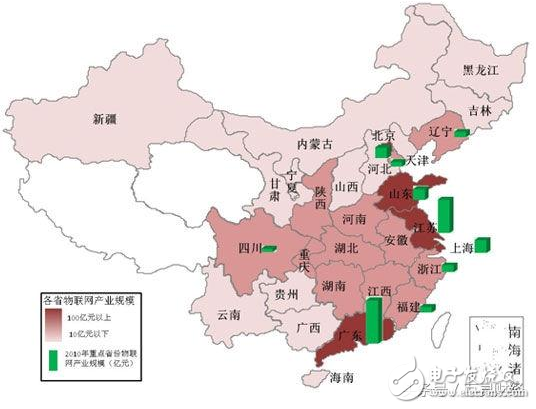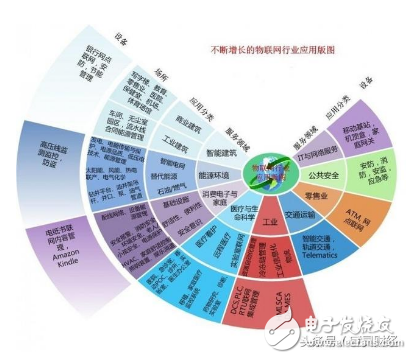The Internet of Things Developers Conference, which attracted Microsoft, Intel, IBM and other international giants, will be held in Beijing on December 9. The conference was jointly organized by the China Institute of Science and Technology Information and the American International Data Group. It is a summit in the field of Internet of Things. Will it be the next "industrial revolution"? Will it change the way people live, work, play and travel?
First, the past and present of the Internet of Things
What is the Internet of Things? It is the third wave of the development of the world information industry after the computer and the Internet. It uses communication technologies such as local networks or the Internet to connect sensors, controllers, machines, people and things in a new way to form people and things. The object and the object are connected to realize the informationization, remote management control and intelligent network.
At present, the Internet of Things has quietly changed our lives, and his "birth" has been 26 years. It can be traced back to the Xerox network cola sales machine in 1990. Bill Gates also wrote in 1995. Mention the Internet of Things. However, it is generally accepted at home and abroad that Professor Ashton of the MIT Auto-ID Center first proposed in 1999 when studying RFID.

The continuous development of the current Internet technology has also made the Internet of Things wind and wave. From the initial sensing application to the current intelligent application, the Internet of Things has gradually matured. According to Cisco's latest report, in the next 10 years, the Internet of Things will bring a huge market worth US$14.4 trillion. The next one-third of the Internet of Things market opportunities are in the US, 30% in Europe, and China and Japan will each occupy 12% and 5%.
Second, the status quo of the Internet of Things
Just as the Internet is solving the last 1 km problem, the Internet of Things actually needs to solve the last 100 meters. In the last 100 meters, the density of connectable devices is far more than the last 1 km, especially in the home, home Internet of Things applications ( That is to say, smart homes have become the commanding heights of IoT companies in all countries. As the world's last recognized 100-meter main technical solution, ZigBee has received unprecedented attention from major countries around the world. Some wireless technologies such as WiFi, Bluetooth, and 433M/315M are more secure and reliable. At the same time, due to their strong networking capabilities, network self-healing capabilities, and lower power consumption, these features of ZigBee are very close to the development requirements of the Internet of Things. It has become the world's best technology solution for the last 100 meters.
Third, the Internet of Things at home and abroad
After taking office, President Obama responded positively to the concept of "smart planet" proposed by IBM and quickly upgraded the IoT plan to a national strategy. In 2004, Japan launched U-Japan, a national informationization strategy based on the Internet of Things. At the Global IoT Conference in November 2009, EU experts introduced the EU IoT Action Plan, which is intended to lead the development of the Internet of Things in the world.
As early as 1999, China launched the research on the core sensor network technology of the Internet of Things, and its research and development level is in the forefront of the world. In August 2009, Wen Jiabao’s “Perceive China†speech pushed the research and application development of China’s Internet of Things field to a climax. Wuxi took the lead in establishing the “Perception China†research center, Chinese Academy of Sciences, operators, and many universities in Wuxi. Established the Institute of Internet of Things. At the same time, China has introduced many policies to support the development of the Internet of Things. The research and open source projects of universities have provided technical and theoretical support for the development of the Internet of Things in China. At the same time, there are many problems that need to be resolved in our intellectual property, technical standards, industrial chain and profit model. The following picture shows the regional distribution of the development of China's Internet of Things:

Fourth, the application of the Internet of Things
In the current service industry where the scene and content are king, there will be more demand at the same time as the material is extremely rich. The “smart +†wave of the Internet of Things (the “Intelligence†phase of the Internet of Things) is meeting the existing At the same time of demand, it is still leading the trend.

The Internet of Things industry ecosystem consists of three parts: the infrastructure layer, the platform layer (horizontal) and the application layer (vertical). On the basis of the maturity of the first two parts, nowadays, from the personal application of wearable devices to smart home, transportation, medical and industrial Internet, the scale of our application is still changing.
Fifth, the Internet of Things
At present, no one will deny the value of the Internet of Things. There are many companies in the huge IoT industry chain. Here are some of the more representative companies in the A-share market:
East China Science and Technology: East China Science and Technology is one of the core manufacturers of the Internet of Things.
Sanchuan Wisdom: Domestic wisdom water industry leader, while entering the Internet of Things big data field.
Yuanwang Valley: The company has invested in five Internet of Things projects, including the railway track number intelligent tracking device.
Eastcompeace: The business scope is involved in multiple smart card applications such as identification, RFID (electronic tags).
Yitong Century: Joint venture to establish a subsidiary to increase the layout of the IoT application management platform; cooperate with Jasper, the world's best Internet of Things platform, to provide carrier-grade IoT connectivity, which is expected to become the first choice for domestic industrial-grade interconnection in terms of transmission capacity and reliability. Cooperate with China Unicom to launch the power network operation.
Since the development of the Internet of Things strategy in China in 2009, the rapid development of the Internet of Things has caused relevant industries and related talents to receive much attention. Up to now, 29 universities in China, including Harbin Institute of Technology, Beiyou and Nanyou, have opened Internet of Things, which has fostered talent storage and distribution for the development of the Internet of Things. The industrial revolution caused by the Internet of Things is changing and changing our way of life in the future. The rapid development of the current Internet of Things is in line with the trend of China's industrial upgrading, embracing the Internet of Things and embracing a better life.
Hotsale products
SHENZHEN HONK ELECTRONIC CO., LTD , https://www.honktech.com